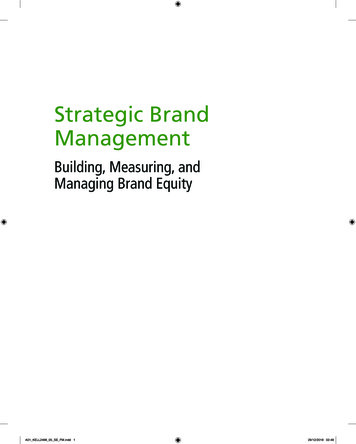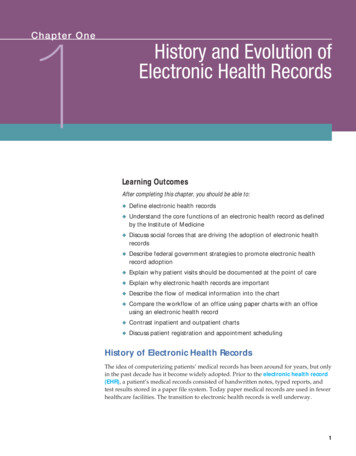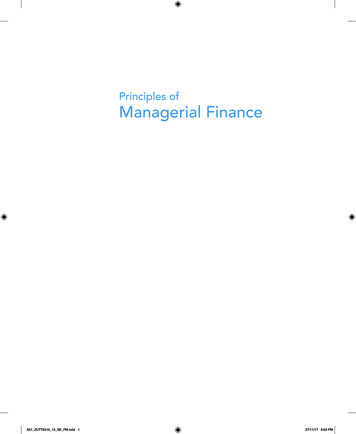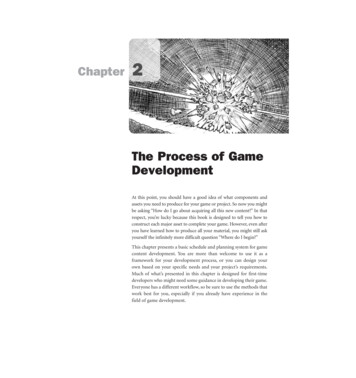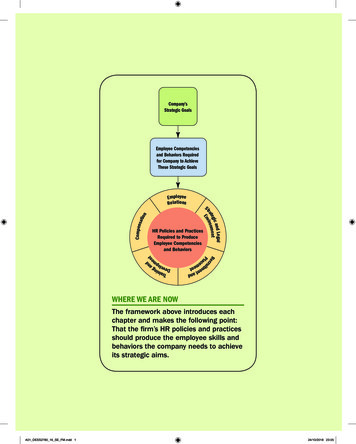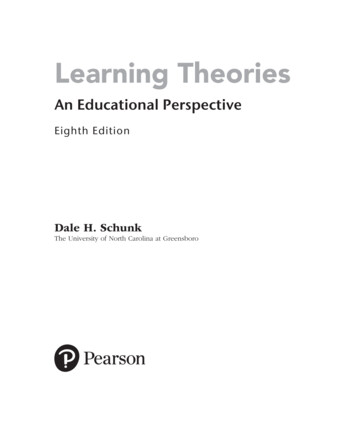
Transcription
Learning TheoriesAn Educational PerspectiveEighth EditionDale H. SchunkThe University of North Carolina at GreensboroA01 SCHU3754 08 SE FM.indd 110/17/18 12:26 AM
Director and Publisher: Kevin M. DavisContent Producer: Janelle RogersMedia Producer: Lauren CarlsonPortfolio Management Assistant: Casey CoriellExecutive Field Marketing Manager: Krista ClarkExecutive Product Marketing Manager: Christopher BarryProcurement Specialist: Carol MelvilleFull-Service Project Management: Thistle Hill Publishing Services, LLCCover Designer: Carie Keller, Pearson CSCCover Image: Tom Gril / JGI / Blend Images / Getty ImagesComposition: Pearson CSCPrinter/Binder: LSC Communications, Inc. / CrawfordsvilleCover Printer: Phoenix Color/HagerstownText Font: 10/12 ITC Garamond StdCredits and acknowledgments borrowed from other sources and reproduced, with permission, in this textbook appearon the appropriate page within the text.Every effort has been made to provide accurate and current Internet information in this book. However, the Internet andinformation posted on it are constantly changing, so it is inevitable that some of the Internet addresses listed in thistextbook will change.Copyright 2020, 2016, 2012 by Pearson, Inc., 221 River Street, Hoboken, NJ 07030. All rights reserved. Printed inthe United States of America. This publication is protected by Copyright, and permission should be obtained from thepublisher prior to any prohibited reproduction, storage in a retrieval system, or transmission in any form or by anymeans, electronic, mechanical, photocopying, recording, or likewise. To obtain permission(s) to use material from thiswork, please visit http://www.pearsoned.com/permissions/Library of Congress Cataloging-in-Publication DataNames: Schunk, Dale H., author.Title: Learning theories : an educational perspective / Dale H. Schunk, TheUniversity of North Carolina at Greensboro.Description: Eighth Edition. New York, NY : Pearson, [2018] Includesbibliographical references and index.Identifiers: LCCN 2018034999 ISBN 9780134893754 (paperback) ISBN0134893751 (paperback)Subjects: LCSH: Learning. Cognition. Learning, Psychology of.Classification: LCC LB1060 .S37 2018 DDC 370.15/23—dc23LC record available at https://lccn.loc.gov/201803499910987654321ISBN 13: 978-0-13-489375-4ISBN 10: 0-13-489375-1A01 SCHU3754 08 SE FM.indd 210/17/18 12:26 AM
DedicationTo Albert Bandura, for helping me develop self-efficacyfor leading a fulfilling lifeA01 SCHU3754 08 SE FM.indd 310/17/18 12:26 AM
PrefaceLearning is a lifelong activity and fundamental to education. And the study of learning iscrucial for everyone who wants to live a fulfilling life and help others do so. The betterwe understand learning, the better we can determine how to improve it.Over the past several years, the study of learning by researchers has continued at astrong pace. This situation is desirable because it has resulted in theoretical refinements,improved research methodologies, and implications for instruction based on sound theory and research.Although the study of learning has changed a lot since the first edition of this bookwas published in 1991, the primary objectives of this eighth edition remain much thesame as those of the first edition: (a) to help students become knowledgeable of learningtheoretical principles, concepts, and research findings, especially as they relate to education, and (b) to provide applications of principles and concepts in settings where teaching and learning occur. As in previous editions, the focus of the current edition is oncognition. Cognitive constructivist perspectives emphasize that learners are not passiverecipients of information but rather actively seek, construct, and adapt their knowledge,skills, strategies, and beliefs.STRUCTURE OF THIS TEXTThe text’s 12 chapters are organized as follows. The introductory chapter covers learningtheory, research methods, and learning issues, as well as historical foundations of thestudy of learning. Chapter 2 discusses the neuroscience of learning. A basic understanding of neuroscience assists readers in understanding the links between brain functionsand cognitive and constructivist learning principles. Chapter 3 covers behaviorism, adominant learning theory for many years. Current cognitive and constructivist theoriesand principles are the subject of Chapters 4–8: social cognitive theory; information processing theory—encoding and storage; information processing theory—retrieval and forgetting; cognitive learning processes; and constructivism. Chapters 9–11 cover topicsrelevant to and integrated with learning: motivation, self-regulated learning, and contextual influences. The final chapter asks learners to develop their own perspective on learning.NEW TO THIS EDITIONReaders familiar with prior editions will notice content and organizational changes in thisedition, which reflect new theoretical and research emphases. Several topics have beenadded including sections on educational data mining, positive behavior supports,ivA01 SCHU3754 08 SE FM.indd 410/17/18 12:26 AM
Preface v etacognition and epistemic thinking, Neo-Piagetian theories, self-regulation and techmnology, and future developments in the study of learning. The text has been revised toincorporate newer theoretical principles and research findings. These revisions are mostevident in the chapters on constructivism and contextual influences. Sections on technology throughout the text have been revised to keep up with the latest educational uses oftechnology. Added to the ends of each of the first eleven chapters are two new sections:a chapter critique and a set of reflection questions that students can think about as theyreview the chapter and can be discussed in classes. To keep the text current and timely,new terms have been incorporated into the glossary. More than 200 new references havebeen added, and several dated references have been dropped.Applications of learning principles have been a hallmark of this text since its inception and these continue to be present in this new edition. Each chapter except the introductory and concluding chapters contains a section on instructional applications. Allchapters begin with vignettes that illustrate some principles discussed in the chapters.Throughout the chapters, there are many informal examples and detailed applications.Most of the applications involve K–12 settings, but applications also address other learning contexts including college students.The text is designed for graduate students in education or related disciplines, as wellas upper-level undergraduates interested in education. It is assumed that most studentshave taken a course in education or psychology and currently work in an educationalcapacity or anticipate pursuing an educational career. The text is appropriate for courseson learning and cognition, as well as any course that covers learning in some depth suchas courses on motivation, educational psychology, human development, and instructionaldesign.ACKNOWLEDGEMENTSMany people deserve thanks for their contributions to this edition. Over many years,there have been numerous professional colleagues who have assisted me to develop mythinking about learning processes and applications. I have acknowledged the contributions of these individuals in previous editions. For this edition, I want to gratefully thankHéfer Bembenutty, Herb Clark, Maria DiBenedetto, Jeff Greene, Judith Meece, EllenUsher, Bernard Weiner, Allan Wigfield, Phil Winne, and Barry Zimmerman. My association with members of professional organizations has been most beneficial, especially theMotivation in Education and the Studying and Self-Regulated Learning Special InterestGroups of the American Educational Research Association, and Division 15 (EducationalPsychology) of the American Psychological Association. It has been an honor for me towork with many excellent students, teachers, counselors, administrators, and superintendents. I also am indebted to several graduate and undergraduate student collaboratorswho assisted me on research projects.I am most fortunate that again for this edition my editor at Pearson Education is KevinDavis. Kevin unquestionably is one of the finest editors anyone could work with. He ishighly encouraging and supportive, and his continued guidance has resulted in a betterproduct. I also express appreciation to Casey Coriell and Janelle Rogers at PearsonA01 SCHU3754 08 SE FM.indd 510/17/18 12:26 AM
viPrefaceEducation for their editorial assistance. I owe sincere thanks to the following reviewers ofthe eighth edition: Oris Griffin, James Madison University; James R. May, Oklahoma StateUniversity; Kerry Rice, Boise State University; Melissa Stormont, University of Missouri;and Ellie L. Young, Brigham Young University.It is hard to believe that it has been almost 30 years since the first edition of this bookwas published. At that time, I proudly gave a copy to my parents, the late Mil andAl Schunk, for their love, encouragement and support. Since then, several friends haveserved as inspirations to me to continue to produce new editions. For this edition,I graciously thank Bill Gattis. And I am most grateful for my wife Maria and my daughterLaura, who was born shortly before the first edition was released. Laura is a remarkableyoung woman from whom I have learned so much and in whose life learning has madea profound difference.A01 SCHU3754 08 SE FM.indd 610/17/18 12:26 AM
Brief Contents1Introduction to the Study of Learning2Neuroscience of Learning303Behaviorism784Social Cognitive Theory1245Information Processing Theory: Encoding and Storage1686Information Processing Theory: Retrieval and Forgetting2167Cognitive Learning -Regulated Learning41611Contextual Influences46212Next Steps508Glossary1514References 527Author Index569Subject Index 582viiA01 SCHU3754 08 SE FM.indd 710/17/18 12:26 AM
Contents1 Introduction to the Study ofLearning 12Organization and Structures 32Neural Organization 33Brain Structures 34Localization and Interconnections 38Brain Research Methods 40Learning Defined 3Precursors of Modern LearningTheories 4Learning Theory and Philosophy 5Beginnings of the Psychological Study ofLearning 7Structuralism and Functionalism 8Learning Theory and Research 11Functions of Theory 11Conducting Research 11Neurophysiology of Learning 44Information Processing System 44Memory Networks 48Language Learning 51Brain Development 52Influential Factors 52Phases of Development 54Sensitive Periods 55Language Development 57Influence of Technology 60Assessment of Learning 14Direct Observations 16Written Responses 16Oral Responses 17Ratings by Others 17Self-Reports 17Educational Data Mining 19Assessment Issues 20Relation of Learning andInstruction 21Critical Issues for LearningTheories 23How Does Learning Occur? 24How Does Memory Function? 25What Is the Role of Motivation? 25How Does Transfer Occur? 26How Does Self-Regulated LearningOperate? 26What Are the Implications forInstruction? 27Summary and Critique 27Reflection Questions 29Further Reading 29Neuroscience of Learning 30Motivation and Emotions 61Motivation 62Emotions 64Instructional Applications 67Relevance of Brain Research 67Brain Myths 67Educational Issues 68Brain-Based Educational Practices 70Summary and Critique 73Reflection Questions 77Further Reading 773Behaviorism 78Connectionism 80Trial-and-Error Learning 80Principles of Learning 81Thorndike and Education 83viiiA01 SCHU3754 08 SE FM.indd 810/17/18 12:26 AM
Contents ixClassical Conditioning 84Basic Processes 85Informational Variables 87Conditioned Emotional Reactions 87Contiguous Conditioning 89Acts and Movements 89Habit Formation and Change 90Motivational Processes 143Goals 143Outcome Expectations 147Values 149Self-Efficacy 150Conceptual Framework 94Basic Processes 95Behavior Change 103Behavior Modification 105Contemporary Perspective 107Conceptual Overview 150Self-Efficacy in AchievementContexts 152Models and Self-Efficacy 154Motor Skills 156Teacher Self-Efficacy 157Health and TherapeuticActivities 159Instructional Applications 108Instructional Applications 160Operant Conditioning 93Behavioral Objectives 109Learning Time 111Mastery Learning 113Differentiated Instruction 115Contingency Contracts 118Summary and Critique 120Reflection Questions 122Further Reading 1234Social Cognitive Theory 124Conceptual Framework forLearning 126Reciprocal Interactions 127Enactive and Vicarious Learning 128Learning and Performance 129Self-Regulation 129Modeling Processes 130Theories of Imitation 130Functions of Modeling 132Cognitive Skill Learning 135Motor Skill Learning 137Influences on Learning andPerformance 139Developmental Status of Learners 139Model Prestige and Competence 140Vicarious Consequences to Models 141A01 SCHU3754 08 SE FM.indd 9Models and Self-Efficacy 160Worked Examples 161Tutoring and Mentoring 162Summary and Critique 163Reflection Questions 166Further Reading 1675 Information Processing Theory:Encoding and Storage 168Early Information ProcessingPerspectives 170Assumptions 170Verbal Learning 170Gestalt Theory 173Two-Store (Dual) MemoryModel 176Levels (Depth) of Processing 178Contemporary InformationProcessing Model 180Attention 182Theories of Attention 182Attention and Learning 183Meaning and Importance 184Perception 186Sensory Registers 186LTM Comparisons 18710/17/18 12:26 AM
xContentsEncoding 188Working Memory (WM) 188Influences on Encoding 191Long-
Héfer Bembenutty, Herb Clark, Maria DiBenedetto, Jeff Greene, Judith Meece, Ellen Usher, Bernard Weiner, Allan Wigfield, Phil Winne, and Barry Zimmerman. My associa- tion with members of professional organizations has been most beneficial, especially the Motivation in Education and the Studying and Self-Regulated Learning Special Interest Groups of the American Educational Research .




